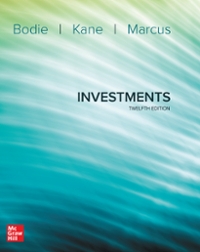Question
Future Value 1A. the process for converting present values into future values is called? Compounding Discounting 1B. this process requires knowledge of the values of
Future Value
1A. the process for converting present values into future values is called?
- Compounding
- Discounting
1B. this process requires knowledge of the values of 3 of 4 time-value-of-money variables. Which of the following is NOT one of these variables?
- The interest rate (R) that could be earned by invested funds
- The inflation rate indicating the change in average prices
- The duration of the investment (n)
- The present value (PV) of the amount invested
2. All other things being equal, the numerical difference between a present & future value corresponds to the amount of interest earned during the deposit or investment period. Each line on the graph corresponds to an interest rate: 0%, 11% or 22%. Identify the rate the goes with each line.
Please look at the attached file for the picture
2A = 0%, 11% or 22% 2B = 0%, 11% or 22% 2C = 0%, 11% or 22%
3. Investments & loans base their interest calculations on 1 of 2 possible methods: The ___A___ interest & ___B___ interest methods
- Choices for A is which? Complex or Simple
- Choices for B is which? Uncomplicated or Compound
Both methods apply 3 variables, the amount of principal, interest rate & the investment or deposit period-to the amount deposited or invested in order to compute the amount of interest. However, the 2 methods differ in their relationship between variables. Assume that the variables r, n, & PV represent the interest rate, investment or deposit period, & present value of the amount deposited or invested, respectfully. Which equation best represents the calculation of a future value (FV) using:
4A. Compound interest?
- FV = PV x (1+r)n
- FV = (1+r)n /PV
- FV = PV + (PV x r x n)
4B. Simple Interest?
- FV = PV + (PV x r x n)
- FV = PV x r x n
- FV = PV x (PV x r x n)
5. Identify which statements are TRUE & which are FALSE
A. The process of earning compound interest allows a depositor or investor to earn interest on any interest earned in prior periods. (T/F)
B. All other factors being equal, both the simple & compound interest methods will NOT generate the amount of earned interest by the end of the 1st year. (T/F)
C. After the end of the 2nd year & all other factors remaining equal, a future value based on compound interest will exceed a future value based on simple interest. (T/F)
6. Sarah is willing to invest $30K for 3 years & is an economically rational investor. She?s identified 3 investment alternatives (L, M & P) that vary in their method of calculating interest & in the annual interest rate offered. She can only make 1 investment in the 3 year period. Complete the following table by inserting the Expected Future Value & indicate whether Sarah should or should not invest in each.
|
|
|
| Make Investment |
| Investment | Interest Rate & Method | Expected Future Value | Yes or No |
| L | 9% compound interest | ??? |
|
| M | 8% simple interest | ??? |
|
| P | 15% compound interest | ??? |
|

Step by Step Solution
There are 3 Steps involved in it
Step: 1

Get Instant Access to Expert-Tailored Solutions
See step-by-step solutions with expert insights and AI powered tools for academic success
Step: 2

Step: 3

Ace Your Homework with AI
Get the answers you need in no time with our AI-driven, step-by-step assistance
Get Started


